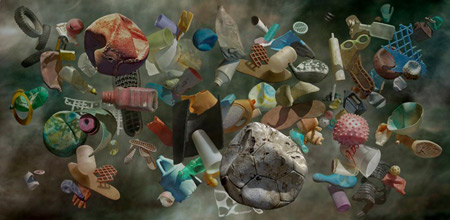
Continuing through March 7, 2013
At the end of H.G. Wells’ fantastic 1901 sci-fi novel, "The First Men in the Moon" he imagines the earth hanging in dark space as a bright green planet the color of growing things. Not until the iconic Apollo 8 color photograph “Earthrise”, taken in 1968, did the image of earth as a vivid blue world of water enter the popular imagination. But that’s not surprising. We are land dwellers after all. That perspective often colors our imagination and limits our vision. We habitually stand on shore and look out to sea, feeling distant and isolated from what affects it. In "Washed Up: Ocean in Peril" twenty artists address that land-based perspective and its inherent dire consequences. It’s a welcome examination.
Tides are the circulatory system of the planet and as the saying goes, what goes around comes around. That simple truth is at the core of much of the thoughtful work in this exhibit. Lowell Nickell’s colorful photomontages turn images of collected flotsam into expanding, cosmic explosions of cast off, traveling junk. Michael Davis’ sculpture “Currents” contains scores of glass fishing floats from Japan that washed up on the beach near his home. They are clustered under a large circle of glass that is deeply etched with a linear map that renders, in a splayed, circular image, all of earth’s seas and landmasses. The work is a gentle reminder that eventually we all are touched by the ocean’s accidents, even those that happen on the other side of the world. Satoe Fukushima’s hanging cube of smiling faces and its accompanying story about visiting the survivors of the recent tsunami that hit Japan forces reflection on the radioactive implications of the globally circulating current, even as she puts the focus on gratitude rather than grief.
Yet it is with our accustomed land bound sense of detachment that we look at the raku-fired pile of squashed juice bottles by Jan Davids. We find ourselves beguiled by their shiny, iridescent colors. So deep is our customary enjoyment of art’s beauty that we have to remind ourselves of the disturbing fact that Davids' mound of bottles alludes to a larger, nearly unalterable, tide of plastic waste. Similarly George Geyer’s slabs of stained and rotted fired clay that he originally hung off a boat dock form a very quiet testament to tides of motor oil and trash that regularly washed in and out of the marina. They provide a visual record of a seemingly small and transient danger, but also link our thoughts to recent memories of the polluted high watermarks left by hurricane Katrina and tropical storm Sandy.
Although land may be only 29% of the earth’s surface, human waste along with our compelling need to use the ocean for food, security and profit means we are having a devastating effect on the waters that make up the other 71%. Artists like Art Constancio paint haunting images of the imperiled green sea turtles that mistake floating plastic bags for edible jellyfish and suffocate. Olga Seem’s “Crude Attack” paintings depicting underwater denizens in nasty clots of muck bear witness to the scale and ongoing damage of the BP oil spill. Activist and designer Annmarie Dalton notes the Navy’s use of long-range, deep-sea sonar booms in the name of national security, despite the permanent, deafening effects on whales and other mammals for miles and miles. Deaf in the ocean is blind. Blind sea creatures can’t navigate or eat.
That information, like the “Drains to the Ocean” message stamped on neighborhood storm drains, begs us to consider the extended results of our actions. Like Helen and Newton Harrison’s “Book of Lagoons” that poetically analyzed the wisdom of digging a huge sea-bound trench to the Gulf and ocean to flush out the polluted, ultra saline, Salton Sea, this exhibit is a reminder that art forms a visible part of the social network openly considering the results and implications of human interaction with the environment. Toward the end of their Salton Sea project, the Harrisons asked an amazingly clarifying and profound question: “Who will flush the ocean?” Thirty years later, more urgently, “Washed Up: Ocean In Peril” asks again.
Published courtesy of ArtSceneCal ©2013
